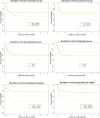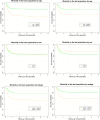Delineating COVID-19 subgroups using routine clinical data identifies distinct in-hospital outcomes
- PMID: 37339958
- PMCID: PMC10282086
- DOI: 10.1038/s41598-023-32469-9
Delineating COVID-19 subgroups using routine clinical data identifies distinct in-hospital outcomes
Erratum in
-
Author Correction: Delineating COVID-19 subgroups using routine clinical data identifies distinct in-hospital outcomes.Sci Rep. 2023 Oct 26;13(1):18376. doi: 10.1038/s41598-023-45343-5. Sci Rep. 2023. PMID: 37884602 Free PMC article. No abstract available.
Abstract
The COVID-19 pandemic has been a great challenge to healthcare systems worldwide. It highlighted the need for robust predictive models which can be readily deployed to uncover heterogeneities in disease course, aid decision-making and prioritise treatment. We adapted an unsupervised data-driven model-SuStaIn, to be utilised for short-term infectious disease like COVID-19, based on 11 commonly recorded clinical measures. We used 1344 patients from the National COVID-19 Chest Imaging Database (NCCID), hospitalised for RT-PCR confirmed COVID-19 disease, splitting them equally into a training and an independent validation cohort. We discovered three COVID-19 subtypes (General Haemodynamic, Renal and Immunological) and introduced disease severity stages, both of which were predictive of distinct risks of in-hospital mortality or escalation of treatment, when analysed using Cox Proportional Hazards models. A low-risk Normal-appearing subtype was also discovered. The model and our full pipeline are available online and can be adapted for future outbreaks of COVID-19 or other infectious disease.
© 2023. The Author(s).
Conflict of interest statement
The authors declare no competing interests.
Figures





References
-
- WHO Coronavirus (COVID-19) Dashboard|WHO Coronavirus (COVID-19) Dashboard With Vaccination Data. https://covid19.who.int/ (Accessed 6 Dec 2021).
Publication types
MeSH terms
Grants and funding
LinkOut - more resources
Full Text Sources
Medical

